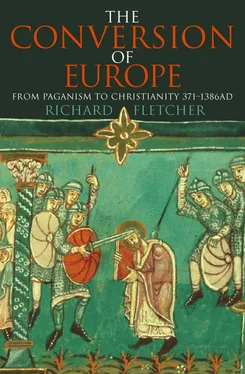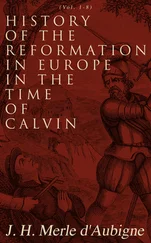Columba’s chain of monasteries crossed the sea: Iona lies off the island of Mull, itself off the western coast of Scotland. But it did not cross cultures. Iona was in the kingdom of Dalriada, which comprised the western islands and coastal hinterland from the Clyde to Ardnamurchan. This area had been settled by Irish migrants at a slightly later date than their settlements in Dyfed. In founding a monastery on Iona, therefore, Columba was among people of his own language and culture. There has been a good deal of discussion about his motives for the move to Iona, traditionally dated to 563, which need not delay us here. Adomnán, and the Iona community for whom he wrote, were clear about the principal reason: ‘In the forty-second year of his age Columba sailed away from Ireland to Britain, wishing to be a pilgrim for Christ.’ We have already met the idea of the Christian’s life as one of exile or pilgrimage in the writings of St Augustine of Hippo. Patrick had described himself in the Epistola as ‘an exile ( profuga ) for the love of God’. We encounter here another point of contact between Christian idealism and Irish social custom. Exile was one of the most severe penalties known to Irish law – severe because it removed the person so punished from the supportive network of kinsmen, lords, retainers and dependants. The exile was quite literally dis-integrated from the protective social and emotional fabric in which he had been cocooned and turned into a defenceless individual.
Columba’s exile was not lifelong. There is plentiful evidence in Adomnán’s biography that he went to and fro between Scotland and Ireland in the years after the foundation of Iona. But some went further down the path of lifelong pilgrimage or exile, cutting loose more decisively from earthly ties in the fashion which the author of Hebrews had commended in Abraham. The pioneer was Columbanus. *
We last glimpsed Columbanus (above, p. 88) receiving an excellent grounding in Latin in the middle years of the sixth century. In about 565 he entered the monastery of Bangor in County Down, recently founded by St Comgall. This was already a fairly considerable step on the road to exile. Columbanus was a native of Leinster, and in betaking himself to Bangor he was, as his biographer Jonas of Bobbio noted, ‘leaving his native country’. 9 At Bangor he would have been well placed to hear the news of Columba’s exploits in Dalriada. His abbot, Comgall, was another founder who presided over a network of monastic houses, including at least one on the island of Tiree (though the source for this is late and perhaps doubtful), where there was also a monastery of the Iona network. However, exile to Bangor was not enough for Columbanus: as Jonas explained, he wanted to live out to the letter the commands uttered to Abraham. Accordingly, after gaining the reluctant assent of Comgall, he set off for Gaul, probably in the late 580s. There, helped by royal and aristocratic patronage, he founded three monastic houses at Annegray, Luxeuil and Les Fontaines on the edge of the Vosges mountains about thirty miles west of the modern town of Mulhouse. After a series of somewhat stormy brushes with the Frankish episcopate and Queen Brunhilde, Columbanus moved on to Bregenz, at the eastern end of Lake Constance, where he planned to found another monastery but in the event did not. His last move took him over the Alps to Italy, where he founded his last monastery at Bobbio, in the Apennines inland from Genoa. There he died in the year 615.
Pilgrimage, in the sense of ascetic renunciation of homeland and kinsfolk, is of special importance in our understanding of the phenomenon of conversion in the early Middle Ages. Pilgrimage merged insensibly into mission. The monasteries that were founded by the exiled holy men had something of the character of mission stations. It was not that they were established primarily among pagans; indeed, they could not have been, dependent as they were on wealthy patrons, necessarily Christian (if we except the case of the pagan would-be benefactors in Ireland), for their endowments. Columba settled among the Christian Irish of Dalriada, Columbanus in the Christian kingdom of the Franks. But their monastic communities were situated on the margins of Christendom, and had what might be called ‘diffusive potential’ among nearby laity who were Christian only in the most nominal of senses.
The point may be illustrated from episodes in the careers of Columba and Columbanus. Bede tells us that Columba came to Britain ‘to preach the word of God to the provinces of the northern Picts’, that is, to the peoples who inhabited north-eastern Scotland between (roughly speaking) Inverness, Aberdeen and Perth. It is unlikely that this was in fact Columba’s motive. He came as a pilgrim or exile. Columba was no more the apostle of Pictland than Ulfila was the apostle of the Goths. Bede’s comments on Columba fall in the same chapter as his two sentences on Ninian and like them may reflect the preoccupations of his own day more than they do the realities of Columba’s. However, we have the evidence of Adomnán that Columba had dealings with the Picts and that he did make some conversions among them. He visited the Pictish King Bridei at his stronghold near Inverness on more than one occasion and converted two households of (apparently) the Pictish aristocracy to Christianity. Here is the story of one conversion as told by Adomnán.
At one time when the holy man [i.e. Columba] was making a journey on the other side of the Spine of Britain [Adomnán’s term for the western Grampians which divided Dalriada from Pictland] beside the lake of the river Ness, he was suddenly inspired by the Holy Spirit, and said to the brothers who travelled along with him: ‘Let us hasten towards the holy angels that have been sent from the highest regions of heaven to conduct the soul of a pagan, and who await our coming thither so that we may give timely baptism, before he dies, to that man, who has preserved natural goodness through his whole life, into extreme old age.’ Saying this, the aged saint went as fast as he could, ahead of his companions, until he came to the farmland that is called Airchartdan [Urquhart]. And a certain old man whom he found there, Emchath by name, hearing and believing the word of God preached by the saint, was baptised; and thereupon, gladly and confidently, with the angels that came to meet him he departed to the Lord. And his son Virolec also believed and was baptised, with his whole house.
As the story of a conversion, it leaves something to be desired. We should not blame Adomnán for this: what he was interested in was (in his own words) ‘the manifestation of angels coming to meet the soul of Emchath’. For our purposes the tale is of interest in showing that Columba the monastic founder was also, on occasions, an evangelist.
From Jonas’ biography of Columbanus we may quote an episode of somewhat similar drift that occurred during his sojourn at Bregenz in or about the year 611.
And then they came to the place where they were going [i.e. Bregenz]. The man of God said that it did not really meet his requirements, but in order to sow the Christian faith in the heathen thereabouts he would stay there for a while. The peoples there were called the Suevi. And while he was there working among the inhabitants of that place he found them preparing to make a profane offering: and they placed a great barrel which in their language they called a cupa , which holds twenty measures or more of ale, in the midst of them. The man of God went up to them and asked what they proposed to do with it. And they said that they were going to sacrifice to their god Woden. He hearing their evil project blew on the cask and it burst with a mighty crack and the ale poured out. It was quite clear that there was a devil hidden in the barrel who by means of the evil drink took captive the souls of those who sacrificed. The barbarians saw this and were astonished and said that they had a great man of God among them who could thus dissolve a barrel fully bound with hoops as it was. He rebuked them and preached the word of God to them and urged them to refrain from these sacrifices. Many of them were persuaded by his words and turned to the Christian faith and accepted baptism. Others who had already been baptised but remained in the grip of pagan error heeded his admonitions as a good shepherd of the church and returned to the observance of gospel teaching.
Читать дальше












